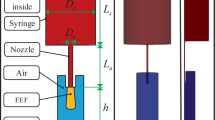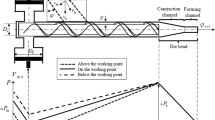Abstract
Direct ink writing (DIW) belongs to material extrusion–based additive manufacturing (MEAM), and the molding quality of deposited corners has an impact on the geometrical quality of three-dimensional (3D) parts fabricated by DIW. To fully understand the DIW process and improve the geometrical quality of parts, numerical simulations have been widely used to model the DIW process. However, the previous research works for numerical simulation of deposited corners could only achieve the corner simulation under the condition of small angle and failed to realize corner simulation of any angle. Herein, an improved numerical simulation of deposited corners of any angle is proposed based on the use of volume of fluid (VOF) method and then the simulation is validated experimentally. In the numerical simulation, deposited corner is realized by constructing two calculation areas where two nozzle velocities with the corner angle are applied on the substrates of two calculation areas. The effectiveness of the proposed numerical model is validated through corner deposition experiments using a commercially available microcrystalline wax (MW)-based ink in a DIW 3D printer as the simulated corner angles fit experimental angles well and the maximum value of maximum distance deviation between simulated and experimental outlines (MDDSEO) is 1.06 ± 0.06 mm. It was observed that the MDDSEO of corners is larger than MDDSEO of straight filaments and decreases as corner angle increases. The current work demonstrates an effective approach for the prediction of the deposited corners of any angle in DIW based on numerical simulations.











Similar content being viewed by others
Availability of data and material
The authors confirm that all data and materials reported in this paper are available.
Code availability
Not applicable.
Abbreviations
- \(\alpha\) :
-
Phase fraction
- \(V_{i}\) :
-
Volume of ink in a mesh
- \(V_{m}\) :
-
Total volume of a mesh
- \(\rho_{s}\) :
-
Density of single continuum
- \(\mu_{s}\) :
-
Viscosity of single continuum
- \(\rho\) :
-
Density of ink
- \(\rho_{a}\) :
-
Density of air
- \(\mu\) :
-
Viscosity of ink
- \(\mu_{a}\) :
-
Viscosity of air
- \(\dot{\gamma }\) :
-
Shear rate
- \(\mu_{0}\) :
-
Limiting dynamic viscosity
- \(\tau_{0}\) :
-
Yield stress
- \(K\) :
-
Consistency index
- \(n\) :
-
Flow index
- \(U\) :
-
Velocity field
- \(p\) :
-
Pressure
- \(g\) :
-
Gravitational acceleration vector
- \(F_{{{\varvec{\upsigma}}}}\) :
-
Surface tension
- \(\sigma\) :
-
Surface tension coefficient
- \(\kappa\) :
-
Surface curvature
- \(n\) :
-
Normal vector to ink surface
- \(\hat{n}\) :
-
Unit vector normal to ink surface
- \(\hat{n}_{w}\) :
-
Unit vector normal to wall
- \(\hat{t}_{w}\) :
-
Unit vector tangent to wall
- \(\theta_{c}\) :
-
Static contact angle
- \(U_{{\mathbf{r}}}\) :
-
Velocity vector compressing two-phase free surface
- \(c\) :
-
Controllable compression factor
- \(v_{e}\) :
-
Average velocity in nozzle
- \(D_{p}\) :
-
Piston diameter
- \(D_{n}\) :
-
Outer diameter of nozzle
- \(d_{n}\) :
-
Inner diameter of nozzle
- \(v_{p}\) :
-
Piston velocity
- \(L_{n}\) :
-
Nozzle length
- \(h\) :
-
Distance between nozzle bottom and substrate
- \(v_{{{\mathbf{n1}}}}\) :
-
Nozzle velocity applied on substrate 1
- \(v_{{{\mathbf{n2}}}}\) :
-
Nozzle velocity applied on substrate 2
- \(\theta\) :
-
Corner angle
- \(v_{nx}\) :
-
Nozzle velocity component along x axis
- \(v_{ny}\) :
-
Nozzle velocity component along y axis
- p*:
-
Statistical significance
References
Kim M, Choi J-W (2021) Rubber ink formulations with high solid content for direct-ink write process. Addit Manuf 44:102023
Campos DF, Philip MA, Gürzing S, Melcher C, Lin YY, Schöneberg J, Blaeser A, Theek B, Fischer H, Betsch M (2019) Synchronized dual bioprinting of bioinks and biomaterial inks as a translational strategy for cartilage tissue engineering. 3D Printing And Additive Manuf 6(2):63–71
Liu C, Qiu Y, Liu Y, Xu K, Zhao N, Lao C, Shen J, Chen Z (2022) Novel 3D grid porous Li4Ti5O12 thick electrodes fabricated by 3D printing for high performance lithium-ion batteries. Journal of Advanced Ceramics 11(2):295–307
Kim T, Bao C, Hausmann M, Siqueira G, Zimmermann T, Kim WS (2019) 3D printed disposable wireless ion sensors with biocompatible cellulose composites. Advanced Electronic Materials 5(2):1800778
Ye Z, Chu C, Zhang D, Ma S, Guo J, Cheng Y, Xu G, Li Z, Sun A (2021) Study on 3D-Direct Ink Writing based on adding silica submicron-particles to improve the rheological properties of alumina ceramic ink. Materials Today Communications 28:102534
Kalkal A, Kumar S, Kumar P, Pradhan R, Willander M, Packirisamy G, Kumar S, Malhotra BD (2021) Recent advances in 3D printing technologies for wearable (bio)sensors. Addit Manuf 46:102088
Mulakkal MC, Trask RS, Ting VP, Seddon AM (2018) Responsive cellulose-hydrogel composite ink for 4D printing. Mater Des 160:108–118
Lille M, Nurmela A, Nordlund E, Metsä-Kortelainen S, Sozer N (2018) Applicability of protein and fiber-rich food materials in extrusion-based 3D printing. J Food Eng 220:20–27
Vergara LA, Colorado HA (2020) Additive manufacturing of Portland cement pastes with additions of kaolin, superplastificant and calcium carbonate. Constr Build Mater 248:118669
Tarassoli S, Jessop Z, Al-Sabah A, Simoes I, Whitaker I (2018) Searching for the optimal bioink in extrusion-based 3D bioprinting for reconstructive surgery. Int J Surg 55:S95
Wilson SA, Cross LM, Peak CW, Gaharwar AK (2017) Shear-thinning and thermo-reversible nanoengineered inks for 3D bioprinting. ACS Appl Mater Interfaces 9(50):43449–43458
Dávila JL, d’Ávila MA (2019) Rheological evaluation of Laponite/alginate inks for 3D extrusion-based printing. The International Journal of Advanced Manufacturing Technology 101(1):675–686
Jessop ZM, Al-Sabah A, Gao N, Kyle S, Thomas B, Badiei N, Hawkins K, Whitaker IS (2019) Printability of pulp derived crystal, fibril and blend nanocellulose-alginate bioinks for extrusion 3D bioprinting. Biofabrication 11(4):045006
Jiang Y, Wang X, Plog J, Yarin AL, Pan Y (2021) Electrowetting-assisted direct ink writing for low-viscosity liquids. J Manuf Process 69:173–180
Fleck TJ, McCaw JCS, Son SF, Gunduz IE, Rhoads JF (2021) Characterizing the vibration-assisted printing of high viscosity clay material. Addit Manuf 47:102256
Akhoundi B, Nabipour M, Kordi O, Hajami F (2021) Calculating printing speed in order to correctly print PLA/continuous glass fiber composites via fused filament fabrication 3D printer. J Thermoplastic Compos Maters 0892705721997534
Giberti H, Sbaglia L, Urgo M (2017) A path planning algorithm for industrial processes under velocity constraints with an application to additive manufacturing. J Manuf Syst 43:160–167
Jin Y, Du J, Ma Z, Liu A, He Y (2017) An optimization approach for path planning of high-quality and uniform additive manufacturing. The International Journal of Advanced Manufacturing Technology 92(1):651–662
Li L, McGuan R, Isaac R, Kavehpour P, Candler R (2021) Improving precision of material extrusion 3D printing by in-situ monitoring & predicting 3D geometric deviation using conditional adversarial networks. Addit Manuf 38:101695
Comminal R, Serdeczny MP, Pedersen DB, Spangenberg J (2018) Numerical modeling of the strand deposition flow in extrusion-based additive manufacturing. Addit Manuf 20:68–76
Comminal R, Serdeczny MP, Pedersen DB, Spangenberg J (2019) Motion planning and numerical simulation of material deposition at corners in extrusion additive manufacturing. Addit Manuf 29:100753
Göhl J, Markstedt K, Mark A, Håkansson K, Gatenholm P, Edelvik F (2018) Simulations of 3D bioprinting: predicting bioprintability of nanofibrillar inks. Biofabrication 10(3):034105
Tu Y, Hassan A, Arrieta-Escobar JA, Siadat A, Yang G (2022) Modeling and evaluation of freeform extruded filament based on numerical simulation method for direct ink writing. The Int J Adv Manuf Technol 120(5):3821–3829
Zong H, Cong Q, Zhang T, Hao Y, Xiao L, Hao G, Zhang G, Guo H, Hu Y, Jiang W (2022) Simulation of printer nozzle for 3D printing TNT/HMX based melt-cast explosive. The International Journal of Advanced Manufacturing Technology 119(5):3105–3117
Pantelidakis M, Mykoniatis K, Liu J, Harris G (2022) A digital twin ecosystem for additive manufacturing using a real-time development platform. The International Journal of Advanced Manufacturing Technology 120(9):6547–6563
Corradini F, Silvestri M (2022) Design and testing of a digital twin for monitoring and quality assessment of material extrusion process. Addit Manuf 51:102633
Hashemi MR, Ryzhakov PB, Rossi R (2020) An enriched finite element/level-set method for simulating two-phase incompressible fluid flows with surface tension. Comput Methods Appl Mech Eng 370:113277
Yang J, Kim J (2020) A phase-field method for two-phase fluid flow in arbitrary domains. Comput Math Appl 79(6):1857–1874
Zheng L, Zheng S, Zhai Q (2021) Reduction-consistent axisymmetric lattice Boltzmann equation method for N-phase fluids. Comput Fluids 218:104857
Li M, Bolotnov IA (2020) The evaporation and condensation model with interface tracking. Int J Heat Mass Transf 150:119256
Scapin N, Costa P, Brandt L (2020) A volume-of-fluid method for interface-resolved simulations of phase-changing two-fluid flows. J Comput Phys 407:109251
Comminal R, Leal da Silva WR, Andersen TJ, Stang H, Spangenberg J (2020) Modelling of 3D concrete printing based on computational fluid dynamics. Cem Concr Res 138:106256
Lian J, Yang X, Ma B, Gou W (2022) A novel method for bounding the phase fractions at both ends in Eulerian multi-fluid model. Comput Fluids 243:105512
Kim MH, Lee Y, Jung W-K, Oh J, Nam SY (2019) Enhanced rheological behaviors of alginate hydrogels with carrageenan for extrusion-based bioprinting. J Mech Behav Biomed Mater 98:187–194
de Sousa MRP, Santana HS, Taranto OP (2020) Modeling and simulation using OpenFOAM of biodiesel synthesis in structured microreactor. Int J Multiph Flow 132:103435
Saha AA, Mitra SK (2009) Effect of dynamic contact angle in a volume of fluid (VOF) model for a microfluidic capillary flow. J Colloid Interf Sci 339(2):461–480
Busse C, Tsivilskiy I, Hildebrand J, Bergmann JP (2021) Numerical modeling of an inductively coupled plasma torch using OpenFOAM. Comput Fluids 216:104807
Liu Q, Li J, Liu J (2017) ParaView visualization of Abaqus output on the mechanical deformation of complex microstructures. Comput Geosci 99:135–144
Paxton N, Smolan W, Böck T, Melchels F, Groll J, Jungst T (2017) Proposal to assess printability of bioinks for extrusion-based bioprinting and evaluation of rheological properties governing bioprintability. Biofabrication 9(4):044107
Zeng L, Zou X (2019) 3D printer self-adaptive levelling algorithm and structure design. 2019 4th International Conference on Mechanical, Control and Computer Engineering (ICMCCE) 1054–10542
Petsiuk AL, Pearce JM (2020) Open source computer vision-based layer-wise 3D printing analysis. Addit Manuf 36:101473
Tu Y, Arrieta-Escobar JA, Hassan A, Zaman UK, Siadat A, Yang G (2021) Optimizing process parameters of direct ink writing for dimensional accuracy of printed layers. 3D Printing and Additive Manuf
Yuk H, Zhao X (2018) A new 3D printing strategy by harnessing deformation, instability, and fracture of viscoelastic inks. Adv Mater 30(6):1704028
Athanasiadis M, Pak A, Afanasenkau D, Minev IR (2019) Direct writing of elastic fibers with optical, electrical, and microfluidic functionality. Advanced Materials Technologies 4(7):1800659
Ertay DS, Yuen A, Altintas Y (2018) Synchronized material deposition rate control with path velocity on fused filament fabrication machines. Addit Manuf 19:205–213
Funding
This work has been supported by the China Scholarship Council (no. 201906020135).
Author information
Authors and Affiliations
Contributions
YT: methodology, simulation, test, writing—original draft. AH: conceptualization, writing—review and editing. AS: supervision. GY: supervision. CZ: conceptualization, writing—review and editing.
Corresponding author
Ethics declarations
Ethics approval
Not applicable.
Consent to participate
Not applicable.
Consent to publish
The publisher has the permission of the authors to publish the given article.
Conflict of interest
The authors declare no competing interests.
Additional information
Publisher's Note
Springer Nature remains neutral with regard to jurisdictional claims in published maps and institutional affiliations.
Rights and permissions
Springer Nature or its licensor holds exclusive rights to this article under a publishing agreement with the author(s) or other rightsholder(s); author self-archiving of the accepted manuscript version of this article is solely governed by the terms of such publishing agreement and applicable law.
About this article
Cite this article
Tu, Y., Hassan, A., Siadat, A. et al. Numerical simulation and experimental validation of deposited corners of any angle in direct ink writing. Int J Adv Manuf Technol 123, 559–570 (2022). https://doi.org/10.1007/s00170-022-10195-2
Received:
Accepted:
Published:
Issue Date:
DOI: https://doi.org/10.1007/s00170-022-10195-2




